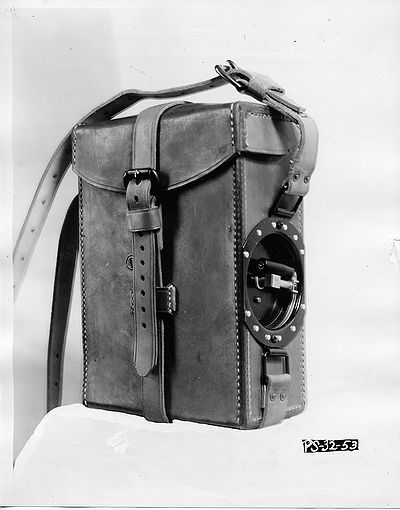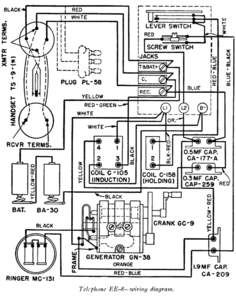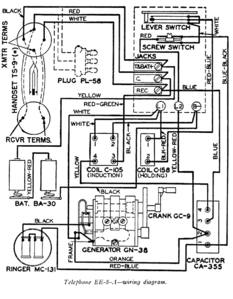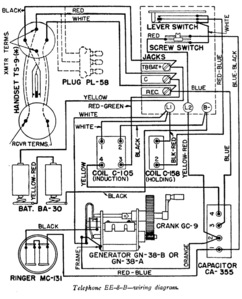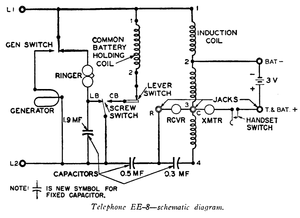Difference between revisions of "EE-8"
RadioNerds (talk | contribs) (→Images) |
|||
| (21 intermediate revisions by 2 users not shown) | |||
| Line 2: | Line 2: | ||
The EE-8 Field Telephone was used by the Signal Corps from before World War II through the Vietnam War. It was housed in leather, then canvas, and its last production had a nylon case and straps, after the changeover to that material in 1967. | The EE-8 Field Telephone was used by the Signal Corps from before World War II through the Vietnam War. It was housed in leather, then canvas, and its last production had a nylon case and straps, after the changeover to that material in 1967. | ||
| − | The EE-8 Field Telephone was standardized in 1932 and procurement began in 1937, providing a lighter and more functional unit just in time for the huge mobilization of the U.S. military for WW II. Among other improvements, the EE-8 increased the maximum transmission range of the predecessor EE-5 Field Telephone by six miles or more. | + | The EE-8 Field Telephone was standardized in 1932 and procurement began in 1937, providing a lighter and more functional unit just in time for the huge mobilization of the U.S. military for WW II. Among other improvements, the EE-8 increased the maximum transmission range of the predecessor EE-5 Field Telephone by six miles or more. utilizes [[ME-22]] maintenance equipment. |
| + | ==Dating notes== | ||
| + | Just to remind everyone, the 2-digit year on the end of a Signal Corps Order Number is the US Federal Fiscal Year, which at the time and for many years afterwards ran from 01 July of the previous calendar year through 30 June of the current calendar year. So the order for the EE-8 was let sometime between 01 July 1943 and 30 June 1944. The Order Sequence Number is 7859 out of at least 40172 (the highest FY 1944 sequence number currently in my database). A simple straight-line approximation would put the calendar year date for 7859 at 09 September 1943. So the phone would probably have been delivered in October or November of 1943. | ||
==Schematics== | ==Schematics== | ||
| Line 26: | Line 28: | ||
File:Photo - Instruction book 10-3-35 014 8753029086 l.jpg | File:Photo - Instruction book 10-3-35 014 8753029086 l.jpg | ||
File:GN-38 8752893646 l.jpg | File:GN-38 8752893646 l.jpg | ||
| + | File:GN-38-A 8752893590 l.jpg | ||
| + | File:Ringer MC-131 8751771541 l.jpg | ||
| + | File:Generators for EE-4A & EE-8 053 8709471746 l.jpg | ||
| + | File:EE-8 8709471390 l.jpg | ||
| + | File:Chest BC-5 8751771599 l.jpg | ||
| + | File:GN-38-B 8751771775 l.jpg | ||
| + | File:Handset used with EE-8 061 8709471460 l.jpg | ||
</gallery> | </gallery> | ||
==Related Files== | ==Related Files== | ||
| + | * TR 1225-10 telephone EE-8, 24 oct. 1938 | ||
| + | |||
;{{pdf|TM-11-333.pdf|TM 11-333}} | ;{{pdf|TM-11-333.pdf|TM 11-333}} | ||
:War Department Technical Manual | :War Department Technical Manual | ||
| Line 36: | Line 47: | ||
::EE-8-B | ::EE-8-B | ||
::March 1945 | ::March 1945 | ||
| + | |||
| + | |||
| + | ;{{cecom_pdf|EE-8A_Russian_Manual.pdf|EE-8A Manual in Russian}} | ||
| + | :Manual in Russian | ||
| + | ::EE-8A | ||
| + | ::1943 | ||
| + | |||
| + | |||
| + | ;{{cecom_pdf|SIG 8-EE-8.pdf|SIG 8-EE-8}} | ||
| + | :Army Service Forces Catalog | ||
| + | :Signal Supply Catalog | ||
| + | :Higher Echelon Spare Parts for | ||
| + | :Telephone | ||
| + | ::EE-8 | ||
| + | ::10 February 1945 | ||
| + | |||
| + | |||
| + | ;{{cecom_pdf|SIG_7_8_EE-8.pdf|SIG 7 & 8 EE-8}} | ||
| + | :Organizational Maintenance Allowances and Field and Depot Maintenance Stockage Guide | ||
| + | :Telephone | ||
| + | ::EE-8; EE-8-A, B, C, D, E | ||
| + | ::29 October 1956 | ||
| + | |||
| + | |||
| + | ;{{cecom_pdf|SIG_10-809.pdf|SIG 10-809}} | ||
| + | :Army Service Forces Catalog | ||
| + | :Signal Supply Catalog | ||
| + | :Fixed Plant Maintenance List | ||
| + | ::Portable Field Telephone | ||
| + | ::EE-8 ( ) | ||
| + | ::15 April 1944 | ||
| + | |||
| + | ==References== | ||
| + | <references /> | ||
[[Category:Military/Field Phones]] | [[Category:Military/Field Phones]] | ||
Latest revision as of 11:55, 16 September 2020
The EE-8 Field Telephone was used by the Signal Corps from before World War II through the Vietnam War. It was housed in leather, then canvas, and its last production had a nylon case and straps, after the changeover to that material in 1967.
The EE-8 Field Telephone was standardized in 1932 and procurement began in 1937, providing a lighter and more functional unit just in time for the huge mobilization of the U.S. military for WW II. Among other improvements, the EE-8 increased the maximum transmission range of the predecessor EE-5 Field Telephone by six miles or more. utilizes ME-22 maintenance equipment.
Dating notes
Just to remind everyone, the 2-digit year on the end of a Signal Corps Order Number is the US Federal Fiscal Year, which at the time and for many years afterwards ran from 01 July of the previous calendar year through 30 June of the current calendar year. So the order for the EE-8 was let sometime between 01 July 1943 and 30 June 1944. The Order Sequence Number is 7859 out of at least 40172 (the highest FY 1944 sequence number currently in my database). A simple straight-line approximation would put the calendar year date for 7859 at 09 September 1943. So the phone would probably have been delivered in October or November of 1943.
Schematics
Images
Related Files
- TR 1225-10 telephone EE-8, 24 oct. 1938
- War Department Technical Manual
- Telephones
- EE-8,
- EE-8-A
- EE-8-B
- March 1945
 EE-8A Manual in Russian[1]
EE-8A Manual in Russian[1]- Manual in Russian
- EE-8A
- 1943
 SIG 8-EE-8[2]
SIG 8-EE-8[2]- Army Service Forces Catalog
- Signal Supply Catalog
- Higher Echelon Spare Parts for
- Telephone
- EE-8
- 10 February 1945
 SIG 7 & 8 EE-8[3]
SIG 7 & 8 EE-8[3]- Organizational Maintenance Allowances and Field and Depot Maintenance Stockage Guide
- Telephone
- EE-8; EE-8-A, B, C, D, E
- 29 October 1956
 SIG 10-809[4]
SIG 10-809[4]- Army Service Forces Catalog
- Signal Supply Catalog
- Fixed Plant Maintenance List
- Portable Field Telephone
- EE-8 ( )
- 15 April 1944
References
- ↑ EE-8A Manual in Russian,
- "US Army Technical Manual Collection,"
- from the CECOM Historical Office archive, Aberdeen Proving Ground, MD.
- CECOM Historical Office
- "US Army Technical Manual Collection,"
- ↑ SIG 8-EE-8,
- "US Army Technical Manual Collection,"
- from the CECOM Historical Office archive, Aberdeen Proving Ground, MD.
- CECOM Historical Office
- "US Army Technical Manual Collection,"
- ↑ SIG 7 & 8 EE-8,
- "US Army Technical Manual Collection,"
- from the CECOM Historical Office archive, Aberdeen Proving Ground, MD.
- CECOM Historical Office
- "US Army Technical Manual Collection,"
- ↑ SIG 10-809,
- "US Army Technical Manual Collection,"
- from the CECOM Historical Office archive, Aberdeen Proving Ground, MD.
- CECOM Historical Office
- "US Army Technical Manual Collection,"
